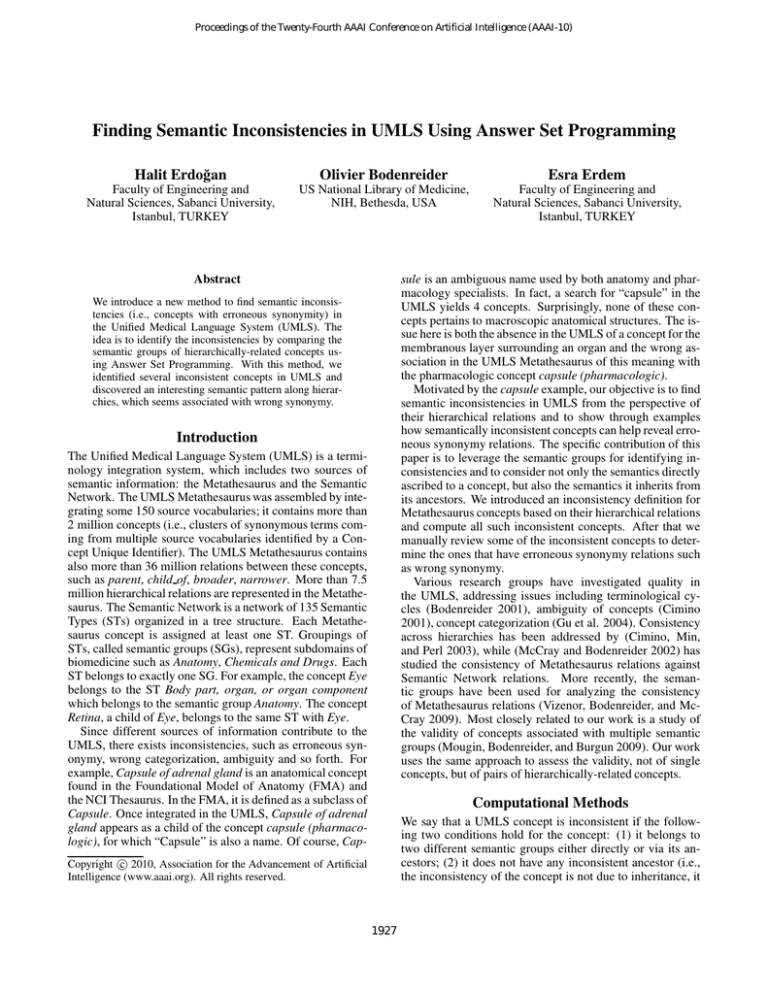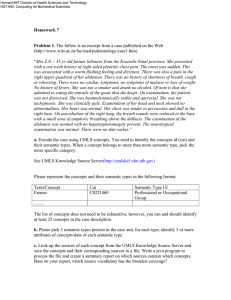
Proceedings of the Twenty-Fourth AAAI Conference on Artificial Intelligence (AAAI-10)
Finding Semantic Inconsistencies in UMLS Using Answer Set Programming
Halit Erdoğan
Olivier Bodenreider
Esra Erdem
Faculty of Engineering and
Natural Sciences, Sabanci University,
Istanbul, TURKEY
US National Library of Medicine,
NIH, Bethesda, USA
Faculty of Engineering and
Natural Sciences, Sabanci University,
Istanbul, TURKEY
Abstract
sule is an ambiguous name used by both anatomy and pharmacology specialists. In fact, a search for “capsule” in the
UMLS yields 4 concepts. Surprisingly, none of these concepts pertains to macroscopic anatomical structures. The issue here is both the absence in the UMLS of a concept for the
membranous layer surrounding an organ and the wrong association in the UMLS Metathesaurus of this meaning with
the pharmacologic concept capsule (pharmacologic).
Motivated by the capsule example, our objective is to find
semantic inconsistencies in UMLS from the perspective of
their hierarchical relations and to show through examples
how semantically inconsistent concepts can help reveal erroneous synonymy relations. The specific contribution of this
paper is to leverage the semantic groups for identifying inconsistencies and to consider not only the semantics directly
ascribed to a concept, but also the semantics it inherits from
its ancestors. We introduced an inconsistency definition for
Metathesaurus concepts based on their hierarchical relations
and compute all such inconsistent concepts. After that we
manually review some of the inconsistent concepts to determine the ones that have erroneous synonymy relations such
as wrong synonymy.
Various research groups have investigated quality in
the UMLS, addressing issues including terminological cycles (Bodenreider 2001), ambiguity of concepts (Cimino
2001), concept categorization (Gu et al. 2004). Consistency
across hierarchies has been addressed by (Cimino, Min,
and Perl 2003), while (McCray and Bodenreider 2002) has
studied the consistency of Metathesaurus relations against
Semantic Network relations. More recently, the semantic groups have been used for analyzing the consistency
of Metathesaurus relations (Vizenor, Bodenreider, and McCray 2009). Most closely related to our work is a study of
the validity of concepts associated with multiple semantic
groups (Mougin, Bodenreider, and Burgun 2009). Our work
uses the same approach to assess the validity, not of single
concepts, but of pairs of hierarchically-related concepts.
We introduce a new method to find semantic inconsistencies (i.e., concepts with erroneous synonymity) in
the Unified Medical Language System (UMLS). The
idea is to identify the inconsistencies by comparing the
semantic groups of hierarchically-related concepts using Answer Set Programming. With this method, we
identified several inconsistent concepts in UMLS and
discovered an interesting semantic pattern along hierarchies, which seems associated with wrong synonymy.
Introduction
The Unified Medical Language System (UMLS) is a terminology integration system, which includes two sources of
semantic information: the Metathesaurus and the Semantic
Network. The UMLS Metathesaurus was assembled by integrating some 150 source vocabularies; it contains more than
2 million concepts (i.e., clusters of synonymous terms coming from multiple source vocabularies identified by a Concept Unique Identifier). The UMLS Metathesaurus contains
also more than 36 million relations between these concepts,
such as parent, child of, broader, narrower. More than 7.5
million hierarchical relations are represented in the Metathesaurus. The Semantic Network is a network of 135 Semantic
Types (STs) organized in a tree structure. Each Metathesaurus concept is assigned at least one ST. Groupings of
STs, called semantic groups (SGs), represent subdomains of
biomedicine such as Anatomy, Chemicals and Drugs. Each
ST belongs to exactly one SG. For example, the concept Eye
belongs to the ST Body part, organ, or organ component
which belongs to the semantic group Anatomy. The concept
Retina, a child of Eye, belongs to the same ST with Eye.
Since different sources of information contribute to the
UMLS, there exists inconsistencies, such as erroneous synonymy, wrong categorization, ambiguity and so forth. For
example, Capsule of adrenal gland is an anatomical concept
found in the Foundational Model of Anatomy (FMA) and
the NCI Thesaurus. In the FMA, it is defined as a subclass of
Capsule. Once integrated in the UMLS, Capsule of adrenal
gland appears as a child of the concept capsule (pharmacologic), for which “Capsule” is also a name. Of course, Cap-
Computational Methods
We say that a UMLS concept is inconsistent if the following two conditions hold for the concept: (1) it belongs to
two different semantic groups either directly or via its ancestors; (2) it does not have any inconsistent ancestor (i.e.,
the inconsistency of the concept is not due to inheritance, it
c 2010, Association for the Advancement of Artificial
Copyright Intelligence (www.aaai.org). All rights reserved.
1927
% define the concepts C with some inconsistent ancestor C1
descendantOfInconsistent(C) :- descendant(C,C1), inconsistent(C1).
% identify the groups G (except conc) that a concept C belongs to,
% such that C is not a descendant of an inconsistent ancestor
groupOfConcept(C,G) :- hasCategory(C,T), hasGroup(T,G), set(n,C), G!= conc.
groupOfConcept(C,G) :- not descendantOfInconsistent(C),
descendant(C,C1), hasCategory(C1,T), hasGroup(T,G), G != conc.
% a concept is originally inconsistent if it belongs to two different groups G and G1
orgn_inconsistent(C) :- groupOfConcept(C,G), groupOfConcept(C,G1), G<G1.
Figure 1: Defining original inconsistencies in ASP
is original).
To compute all inconsistent concepts, we need some
method to find all the ancestors of a concept and their semantic groups, and check the inconsistency of each ancestor.
However, there are over 2 million concepts in the Metathesaurus and some of them have too many ancestors (over
800); and thus it may not be practical to generate all the
ancestors of each concept.
We have introduced a new method for computing inconsistent concepts: first, it divides the set of all UMLS concepts into smaller sets (e.g., of size 20,000); then, for each
set, it computes in parallel all ancestors of its elements in
the whole UMLS graph that are not inconsistent. Therefore,
with this method, we compute the inconsistent concepts as
we compute their ancestors and check their inconsistency.
We have realized this method using Answer Set Programming (ASP) (Lifschitz 2008). The idea is to define the ancestors of concepts, and the inconsistent concepts by means
of (possibly recursive) rules, and then call an existing ASP
system (e.g., the ASP solver CLASP) to find inconsistencies based on these definitions. Figure 1 shows a sample
ASP definition of original inconsistency for a set of concepts. Since recursion is allowed in ASP, we can define hierarchical relations (e.g., descendant). Furthermore, since
ASP has default negation (not), we can define original inconsistencies without generating all paths to their ancestors.
Erdem, and Bodenreider 2010).
Discussion
We have defined inconsistency of concepts in UMLS and
developed an ASP program that identifies them. Interestingly, we have discovered that the four instances of wrong
synonymy we have identified exhibit a pattern of “semantic
rupture” along the hierarchical structure of the terminology.
By semantic rupture, we mean that, along one hierarchy,
the source concept belongs to a given semantic group,
its parent concept does not, but one of the parents of the
parent belongs to the same group as the source concept. We
hypothesize that such pattern of semantic rupture might be
a good marker for wrong synonymy, and plan to test it.
Acknowledgments: This research was supported by the Intramural Research Program of NIH/NLM, and TUBITAK
Grant 108E229.
References
Bodenreider, O. 2001. Circular hierarchical relationships
in the UMLS: etiology, diagnosis, treatment, complications
and prevention. In Proc. of AMIA Symp., 57–61.
Cimino, J. J.; Min, H.; and Perl, Y. 2003. Consistency
across the hierarchies of the UMLS Semantic Network and
Metathesaurus. Biomed. Inform. 36:450–461.
Cimino, J. J. 2001. Battling Scylla and Charybdis: the
search for redundancy and ambiguity in the 2001 UMLS
metathesaurus. In Proc. of AMIA Symp., 120–124.
Erdogan, H.; Erdem, E.; and Bodenreider, O. 2010. Exploiting UMLS semantics for checking semantic consistency among UMLS concepts. In Proc. of MedInfo.
Gu, H.; Perl, Y.; Elhanan, G.; Min, H.; Zhang, L.; and Peng,
Y. 2004. Auditing concept categorizations in the UMLS.
Artif Intell Med 31:29–44.
Lifschitz, V. 2008. What is Answer Set Programming? In
Proc. of AAAI, 1594–1597.
McCray, A. T., and Bodenreider, O. 2002. A conceptual
framework for the biomedical domain. Kluwer. 181–198.
Mougin, F.; Bodenreider, O.; and Burgun, A. 2009. Analyzing polysemous concepts from a clinical perspective:
application to auditing concept categorization in the umls.
Biomed. Inform. 42:440–451.
Vizenor, L. T.; Bodenreider, O.; and McCray, A. T.
2009. Auditing associative relations across two knowledge
sources. Biomed. Inform. 42:426–439.
Results
We have identified 334,396 inconsistent concepts. Out of
these concepts, 81,512 concepts are inconsistent due to the
following reason: the semantic group of the parent differs
from that of the source concept, and no ancestor of the concept is inconsistent. For example, the concept Anti-purkinje
cell antibody is one of these 81,512 concepts: its semantic
group is Chemicals and Drugs, whereas its parent Purkinje
Cells belongs to the semantic group Anatomy; furthermore,
no ancestor of Anti-purkinje cell antibody is inconsistent.
To identify the erroneous synonymy relations, first we
have obtained the distribution of inconsistencies by semantic group of the source concept. After that, we have refined
this map of inconsistencies by looking at the semantic group
of the parent of inconsistent concepts in reference to that of
the source concept. By manual review of pairs of concepts
with inconsistent child of relations, we have identified four
errors (called wrong synonymy) of the same type, including
the “capsule” error mentioned in Introduction.
Further discussion on results can be found in (Erdogan,
1928






